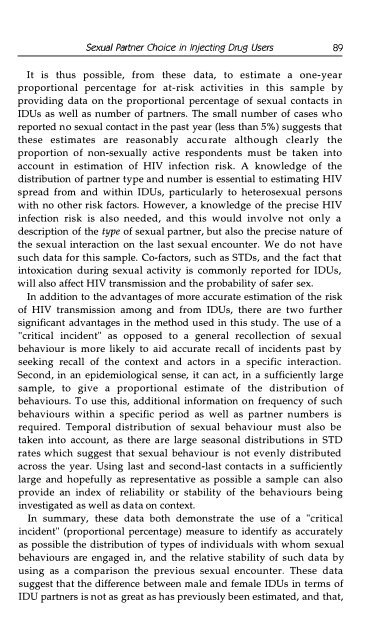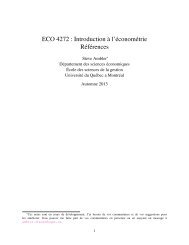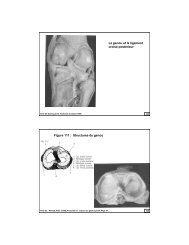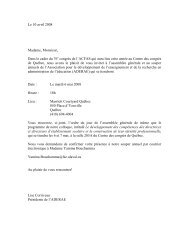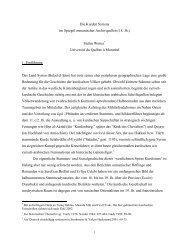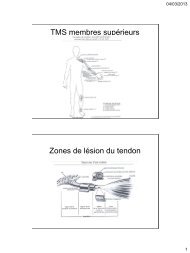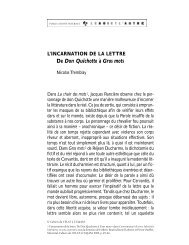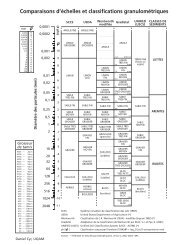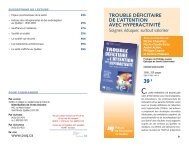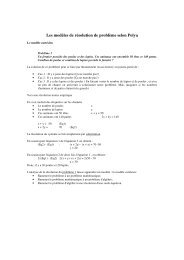Télécharger la revue en format "pdf". - UQAM
Télécharger la revue en format "pdf". - UQAM
Télécharger la revue en format "pdf". - UQAM
Create successful ePaper yourself
Turn your PDF publications into a flip-book with our unique Google optimized e-Paper software.
Sexual Partner Choice in Injecting Drg Users<br />
It is thus possible, from these data, to estimate a one-year<br />
proportional perc<strong>en</strong>tage for at-risk activities in this sam pIe by<br />
providing data on the proportional perc<strong>en</strong>tage of sexual contacts in<br />
IDUs as well as number of partners. The small number of cases who<br />
reported no sexual contact in the past year (less than 5%) suggests that<br />
these estima tes are reasonably accu rate although deady the<br />
proportion of non-sexually active respond<strong>en</strong>ts must be tak<strong>en</strong> into<br />
account in estimation of HIV infection risk. A knowledge of the<br />
distribution of partner type and number is ess<strong>en</strong>tial to estimating HIV<br />
spread from and within IDUs, particu<strong>la</strong>rly to heterosexual persons<br />
with no other risk factors. However, a knowledge of the precise HIV<br />
infection risk is also needed, and this would involve not only a<br />
description of the type of sexual partner, but also the precise nature of<br />
the sexual interaction on the <strong>la</strong>st sexual <strong>en</strong>counter. We do not have<br />
such data for this sample. Co-factors, such as STDs, and the fact that<br />
intoxication during sexual activity is commonly reported for IDUs,<br />
will also affect HIV transmission and the probability of safer sex.<br />
ln addition to the advantages of more accurate estimation of the risk<br />
of HIV transmission among and from IDUs, there are two further<br />
significant advantages in the method used in this study. The use of a<br />
"critical incid<strong>en</strong>t" as opposed to a g<strong>en</strong>eral recollection of sexual<br />
behaviour is more likely to aid ace urate recall of incid<strong>en</strong>ts past by<br />
seeking recall of the context and actors in a specifie interaction.<br />
Second, in an epidemiological s<strong>en</strong>se, it can act, in a suffici<strong>en</strong>tly <strong>la</strong>rge<br />
sample, to give a proportional estima te of the distribution of<br />
behaviours. To use this, additional in<strong>format</strong>ion on frequ<strong>en</strong>cy of such<br />
behaviours within a specifie period as well as partner numbers is<br />
required. Temporal distribution of sexual behaviour must also be<br />
tak<strong>en</strong> into account, as there are <strong>la</strong>rge seasonal distributions in STD<br />
rates which suggest that sexual behaviour is not ev<strong>en</strong>ly distributed<br />
across the year. Using <strong>la</strong>st and second-Iast contacts in a suffici<strong>en</strong>tly<br />
<strong>la</strong>rge and hopefully as repres<strong>en</strong>tative as possible a sample can also<br />
provide an index of reliability or stability of the behaviours being<br />
investigated as weIl as data on context.<br />
ln summary, these data both demonstrate the use of a "critical<br />
incid<strong>en</strong>t" (proportional perc<strong>en</strong>tage) measure to id<strong>en</strong>tify as accurately<br />
as possible the distribution of types of individuals with whom sexual<br />
behaviours are <strong>en</strong>gaged in, and the re<strong>la</strong>tive stability of such data by<br />
using as a comparison the previous sexual <strong>en</strong>counter. These data<br />
suggest that the differ<strong>en</strong>ce betwe<strong>en</strong> male and female IDUs in terms of<br />
IDU partners is not as great as has previously be<strong>en</strong> estimated, and that,<br />
89


